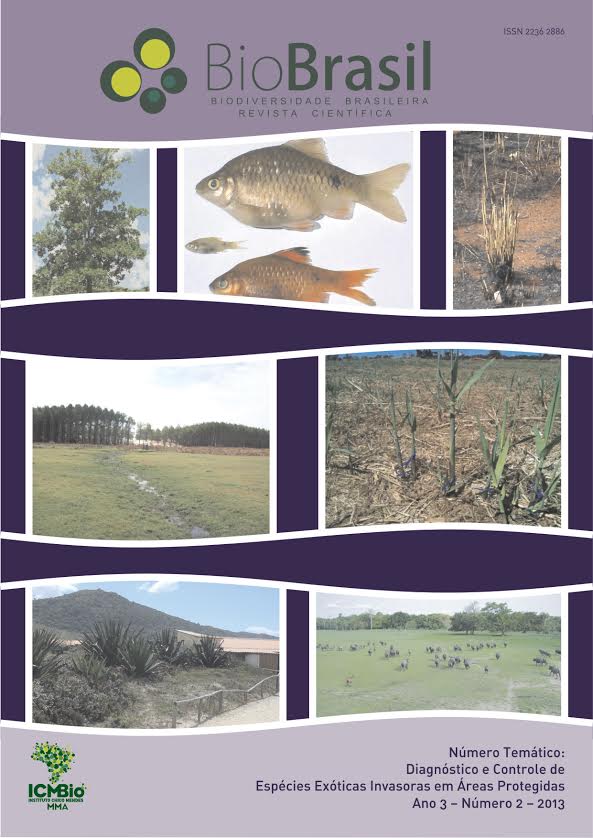Reprodução do peixe não-nativo Barbo-Rosado Pethia conchonius (Hamilton, 1822) (Pisces: Cyprinidae) na Zona de Amortecimento do Parque Estadual da Serra do Brigadeiro (PESB), Minas Gerais
DOI:
https://doi.org/10.37002/biodiversidadebrasileira.v3i2.324Keywords:
conservation unit, creek, non-native fish, Paraíba do Sul River, reproductionAbstract
A study was conducted to evaluate the reproduction of the ornamental non-native fish Pethia
conchonius in a headwater creek located in the buffer zone of Serra do Brigadeiro State Park, Paraíba do Sul
River basin, Minas Gerais state. Collections with sieves occurred bimonthly from January to December 2004 in
Pinheiros Creek. Based on the microscopic characteristics of the gonads, the following stages of reproductive
cycle were determined: 1=Rest, 2=Mature, 3=Spawned for females or Spent for males. Females and males
in reproduction (stages 2 and 3) were found throughout the study period. Spawned ovaries containing
oocytes 1 (initial perinucleolar), 2 (advanced perinucleolar), 3 (previtellogenic), 4 (vitellogenic) and postovulatory follicles indicated fractionated-type spawning in this species. Juveniles were also collected during
the entire period. The sex ratio did not vary between females and males along the year and bimonthly,
being 1:1. Management recommendations such as screens in equipment to prevent fish escapes, continuous
monitoring in ornamental fish farms and awareness are suggested to avoid environmental degradation by
the introduction of P. conchonius and other non-native fishes in the region
References
Bazzoli, N. 2003. Parâmetros reprodutivos de peixes de interesse comercial do rio São Francisco na região de Pirapora, p. 285-300. In: Godinho H.P. & Godinho A.L. (orgs.). Águas, peixes e pesca no São Francisco das Minas Gerais. Editora PUC Minas Gerais. 468p.
Caramaschi, U.; Feio, R.N. & São Pedro, V.A. 2008. A new species of Leptodactylus fitzinger (Anura, Leptodactylidae) from Serra do Brigadeiro, State of Minas Gerais, Southeastern Brazil. Zootaxa, 1861: 44-54.
Cardoso, R.S. & Igarashi, M.A. 2009. Aspectos do agronegócio da produção de peixes ornamentais no Brasil e no mundo. Publicações em Medicina Veterinária e Zootecnia, 3(14): 1-22
Froese, R. & Pauly, D. 2013. FishBase. World wide web electronic publication, version (04/2013). . (Acesso em 05/08/2013). Gibbs, M.A.; Shields, J.H.; Lock, D.W.; Talmadge, K.M. & Farrel, T.M. 2008. Reproduction in an invasive exotic catfish Pterygoplichthys disjunctivus in Volusia Blue Spring, Florida, U.S.A. Journal of Fish Biology, 73(7): 1562-1572.
Gomez-Márquez, J.L.; Peña-Mendoza, B.; Salgado-Ugarte, I.H. & Guzmán-Arroyo, M. 2003. Reproductive aspects of Oreochromis niloticus (Perciformes: Cichlidae) at Coatetelco lake, Morelos, Mexico. Revista de Biologia Tropical, 51(1): 221-228.
Hammer, Ø.; Harper, D.A.T. & Ryan, P.D. 2009. Past: paleontological statistics software package for education and data analysis, version 1.12. Palaeontologia Electronica. . (Acesso em 10/02/2009).
IEF (Instituto Estadual de Florestas). 2013. Instituto Estadual de Florestas. . (Acesso em 20/04/2013).
Lockwood, J.L.; Hoopes, M.F. & Marchetti, M.P. 2007. Invasion ecology. Blackwell Publishing. 304p.
Magalhães A.L.B. 2010. Efeitos da introdução de peixes ornamentais não-nativos em bacias hidrográficas de Minas Gerais. Tese (Doutorado em Ecologia, Conservação e Manejo de Vida Silvestre). Universidade Federal de Minas Gerais. 129p.
Magalhães, A.L.B. & Jacobi, C.M. 2013. Asian aquarium fishes in a Neotropical biodiversity hotspot: impeding establishment, spread and impacts. Biological Invasions, DOI 10.1007/s10530-013-0443-x.
Magalhães, A.L.B. 2007. Polo de piscicultura ornamental de Muriaé, Estado de Minas Gerais: maior fonte dispersora de espécies exóticas do Brasil. Boletim da Sociedade Brasileira de Ictiologia, 86: 5-6.
McAllister, D.E.; Hamilton, A.L. & Harvey, B. 1997. Global freshwater biodiversity: striving for the integrity of freshwater ecosystems. Sea Wind, 11(3): 5-142.
Minas Gerais. 2007. Plano de manejo do Parque Estadual da Serra do Brigadeiro. Instituto Estadual de Florestas. Relatório Técnico. 112p.
Mitra, K.; Suresh, V.R.; Biswas, D.K. & Biswas, B.K. 2011. Biology, population dynamics and fishery of Puntius conchonius (Hamilton) in a floodplain wetland in Ganga River basin, India. Journal of the Inland Fisheries Society of India, 43(1): 16-24.
Neto, F.R.A. 2010. Estado atual do conhecimento sobre a fauna de peixes da bacia do Jequitinhonha. MG.BIOTA, 2: 23-35.
Novomeská A. & Kováč V. 2009. Life-history traits of non-native black bullhead Ameiurus melas with comments on its invasive potential. Journal of Applied Ichthyology, 25(1): 79-84.
Nunn, A.D.; Bolland, J.D.; Harvey, J.P. & Cowx, I.G. 2007. Establishment of self-sustaining populations of non-native fish species in the River Trent and Warwickshire Avon, UK, indicated by the presence of 0+ fish. Aquatic Invasions, 2(3): 190-196.
Reis, R.E.; Kullander, S.O. & Ferrari, C.J. 2003. Check list of the freshwater fishes of South and Central America. EDIPUCRS. 729p.
Santos, A.F.G.N.; Santos, L.N.; García-Berthou, E. & Hayashi, C. 2009. Could native predators help to control invasive fishes? Microcosm experiments with the Neotropical characid, Brycon orbignyanus. Ecology of Freshwater Fish, 18: 491-499.
Talwar, P.K. & Jhingran A.G. 1991. Inland fishes of India and adjacent countries. A.A. Balkema. 541p.
Tempero, G.W.; Ling, N.; Hicks, B.J. & Osborne, M.W. 2006. Age composition, growth, and reproduction of koi carp (Cyprinus carpio) in the lower Waikato region, New Zealand. New Zealand Journal of Marine and Freshwater Research, 40: 571-583.
Vazzoler, A.E.A.M. 1996. Biologia da reprodução de peixes teleósteos: teoria e prática. EDUEM. 169p.
Downloads
Published
Issue
Section
License
Copyright (c) 2021 Biodiversidade Brasileira - BioBrasil

This work is licensed under a Creative Commons Attribution-NonCommercial-NoDerivatives 4.0 International License.
Os artigos estão licenciados sob uma licença Creative Commons Atribuição-NãoComercial-SemDerivações 4.0 Internacional (CC BY-NC-ND 4.0). O acesso é livre e gratuito para download e leitura, ou seja, é permitido copiar e redistribuir o material em qualquer mídia ou formato.





 v3-3-0-3-2-1-8-release.27
v3-3-0-3-2-1-8-release.27